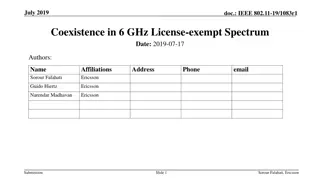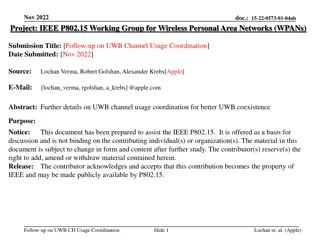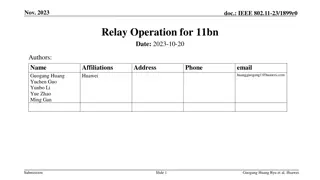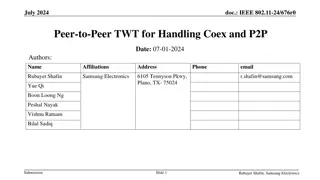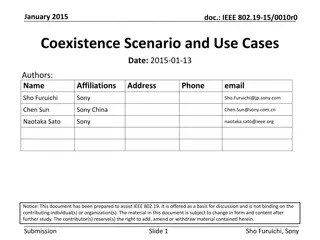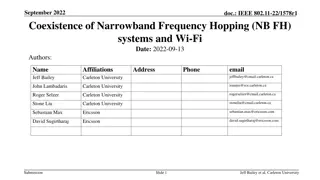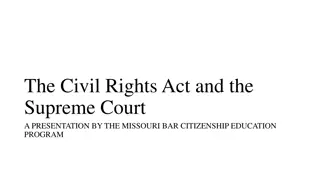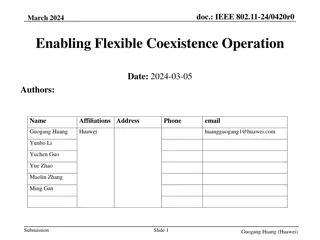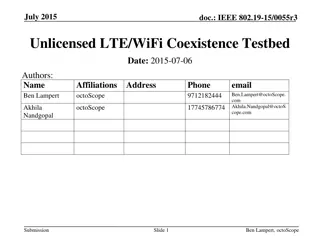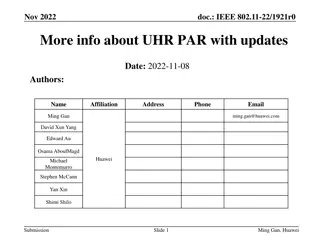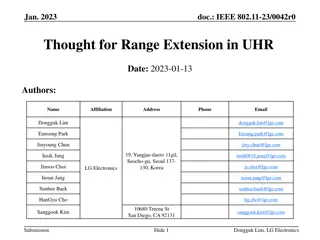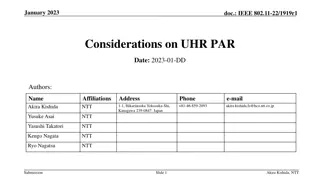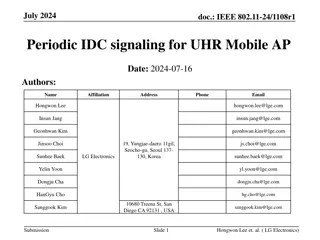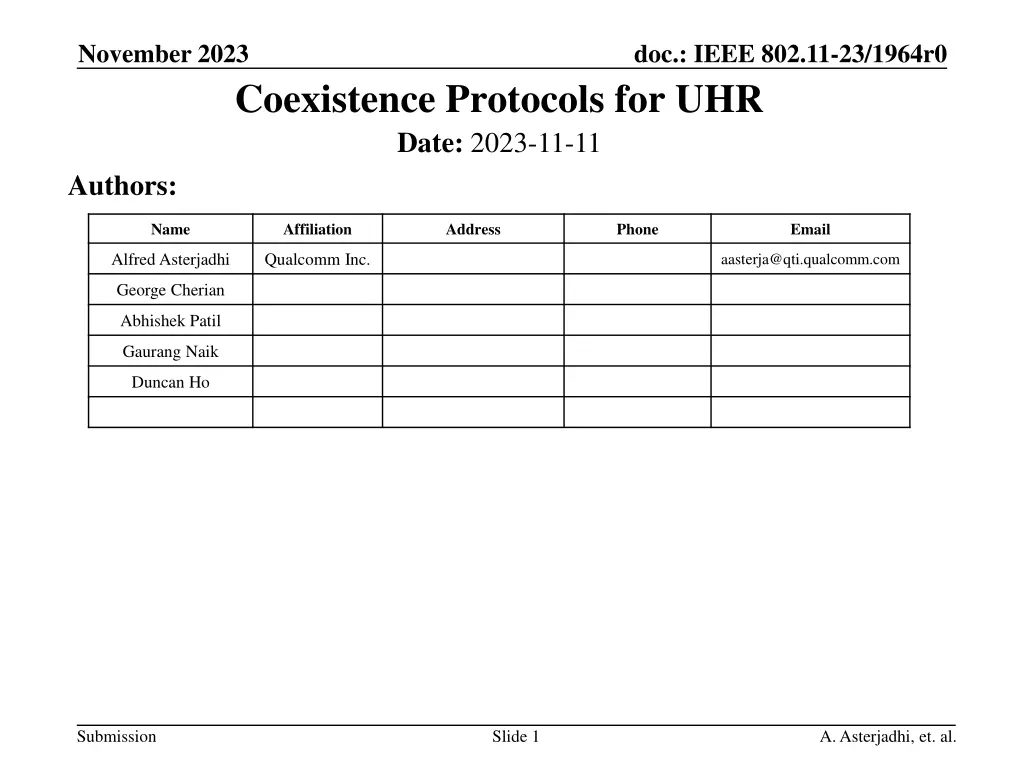
Coexistence Protocols for UHR in IEEE 802.11-23/1964r0
Discover the imperative need for enhanced coexistence in Ultra High Rate (UHR) environments within the IEEE 802.11-23/1964r0 framework. Delve into the challenges surrounding resource sharing and operational limitations while exploring solutions to mitigate data losses, delays, and reliability issues. Gain insights into time/frequency dynamics, antenna subsets, and other key resources affecting coexistence, setting the stage for a comprehensive discussion on improving UHR performance.
Download Presentation

Please find below an Image/Link to download the presentation.
The content on the website is provided AS IS for your information and personal use only. It may not be sold, licensed, or shared on other websites without obtaining consent from the author. If you encounter any issues during the download, it is possible that the publisher has removed the file from their server.
You are allowed to download the files provided on this website for personal or commercial use, subject to the condition that they are used lawfully. All files are the property of their respective owners.
The content on the website is provided AS IS for your information and personal use only. It may not be sold, licensed, or shared on other websites without obtaining consent from the author.
E N D
Presentation Transcript
November 2023 doc.: IEEE 802.11-23/1964r0 Coexistence Protocols for UHR Date: 2023-11-11 Authors: Name Affiliation Address Phone Email Alfred Asterjadhi Qualcomm Inc. aasterja@qti.qualcomm.com George Cherian Abhishek Patil Gaurang Naik Duncan Ho Submission Slide 1 A. Asterjadhi, et. al.
November 2023 doc.: IEEE 802.11-23/1964r0 Introduction A STA can share its radio resources with other technologies (BT, etc.) or with other STAs that are affiliated with the same MLD May not be available at certain times, frequencies, etc., or May operate with limited operational capabilities Improving coexistence in UHR is important; absence of which leads to Data losses, increased delays, reduced reliability, etc. Resources of interest from a coexistence perspective are: 1. Time/Frequency: Link becomes (partially) unavailable at certain times 2. Antennae: Subset of antennas (SS) becomes unavailable 3. Other Resources : Other resources can dynamically change We will be discussing these topics in the next slides Submission Slide 2 Alfred Asterjadhi, Qualcomm Inc.
November 2023 doc.: IEEE 802.11-23/1964r0 1) Time-based Sharing Time (un-)availability: A link can be unavailable/available at certain times Baseline scheduled: TWT, APSD, U-APSD Coexistence Available for non-AP STAs in general, if AP PS enabled then possible at AP side as well Baseline unscheduled: PM-based AM/PS mode transitions, flexible TWT Available for non-AP STAs; requires an explicit exchange to transition between two states Issues/items to address/optimize: STA may not be able to complete frame exchange before an unavailability event E.g., unavailability starts in 5 ms but PM=1 exchange not successful (failure, etc.) Transitions from available to unavailable may be very frequent and not follow strict schedules Candidate Proposals: Add target unavailability/availability in specific Control frames Initial control frame (ICF), initial control resp. (ICR), and control resp. frame (CRF) Should be able to include padding to allow extra processing time of such information Require exchanges with STAs in coex. mode to start with these frames Unavailable Available Target unavailability Target Availability ICF ICR Data Exchange Data Exchanges ICR ICF Submission Slide 3 Alfred Asterjadhi, Qualcomm Inc.
November 2023 doc.: IEEE 802.11-23/1964r0 1) Time/Frequency-Sharing: Cont. Certain Control frames contain target (un)availability times Target Availability Time: when link is expected to be available Target Unavailability Time: when link is expected to be unavailable This, along with dynamic BW negotiation, covers time/frequency aspects of co-existence Some changes to spec needed when these parameters are used for coexistence (enable dynamic BW negotiation with ICF/ICR exchanges, etc.) Submission Slide 4 Alfred Asterjadhi, Qualcomm Inc.
November 2023 doc.: IEEE 802.11-23/1964r0 2) Antenna Sharing Max RX NSS update is generally performed to: Provide in-device coexistence (sharing with other techs (BT, LTE, etc.) Reduce power consumption (reduce NSS in periods of low throughput) Enable dynamic resource management (shift from one link to another) E.g., eMLSR, eMLMR, link enable/disable, etc. Currently, a STA can dynamically adapt the Max RX NSS by sending An OMN frame, or an MPDU containing an OM Control field Changes take effect after the TXOP during which the OM notification occurred Relies on the pre-emptive involvement of RXer in updating the NSS I.e., recipient notifies the transmitter of an NSS change in a timely manner Submission Slide 5 Alfred Asterjadhi, Qualcomm Inc.
November 2023 doc.: IEEE 802.11-23/1964r0 2) Antenna Sharing: Cont. Events that trigger/need an NSS switch may not be predictable RX STA may find out too late that the RX NSS needs to be reduced RX STA may not have enough time to notify the peer STA of an update E.g., due to channel busy, EDCA disabled, peer STA s unavailability, etc. And these events may be very frequent Antennae sharing across multiple links, multiple techs, etc. Which leads to: Underutilization of resources (advertise conservative values) or Data loss (failure to receive due to higher NSS) Ending in reduced throughput, increased delay, and increased power consumption for the STA Submission Slide 6 Alfred Asterjadhi, Qualcomm Inc.
November 2023 doc.: IEEE 802.11-23/1964r0 2) Antenna Sharing: Cont. Proposal: Add Max RX NSS in initial control exchange of a TXOP This along with dyn. BW negotiation ensures a timely & efficient use of BW/NSSs Initiate all exchanges with initial control exchange By default, the recipient is assumed to only use one NSS to listen to the channel TXer may indicate in the ICF the Max RX NSS expected from the RXer RXer either confirms or indicates the Max RX NSSs for that TXOP Similar concept to dynamic BW negotiation RXer switches from 1 to X NSSs after the ICR, and remains until end of TXOP Note: CRF can also update the RX NSSs during the TXOP At the end of the TXOP the RXer switches back to 1 SS MAX RX NSS = 4 MAX RX NSS = 2 CRF ICR ICF Data 2 NSS 1 NSS 1 NSS Pros: Improved power consumption, coexistence, and increased throughput Submission Slide 7 Alfred Asterjadhi, Qualcomm Inc.
November 2023 doc.: IEEE 802.11-23/1964r0 3) Other Resources Sharing A receiving STA may have many other parameters that may be shared E.g., related to memory, processing, RF blocks, etc. And may impact its capability of storing/processing incoming MPDUs A list of parameters (not exhaustive) that reflect the above and may change: Minimum MPDU start spacing, MAC frame processing (BA on/off, fragmentation on/off), max PPDU duration, number of MPDUs that can be aggregated within an A-MPDU, max number of TIDs in a multi-TID A-MPDU, total # of payload bytes in the PPDU, max (e.g., MCS, NSS, BW), LDPC, etc. Real-time modifications of these parameters, while beneficial from RXer perspective, complicate TXer scheduling (APs in particular) and reactiveness To avoid these complications, a careful evaluation of each of these parameters is needed, and if beneficial to allow their update, then the proposal would be to use existing MGMT-level mechanisms (e.g., ML reconfiguration, etc.). Preliminary evaluation points out some parameters of interest that can be updated post-association (Max PPDU duration, max MCS, LDPC, etc.) Submission Slide 8 Alfred Asterjadhi, Qualcomm Inc.
November 2023 doc.: IEEE 802.11-23/1964r0 Conclusion Coexistence is an important topic in need of focused discussions We provided a brief overview of existing coexistence protocols Highlighted certain limitations of these existing protocols Introduced functionalities that could avoid these limitations for UHR And highlighted that additional coexistence protocol design needs to Account not only for the benefits but also for the added complexities Submission Slide 9 Alfred Asterjadhi, Qualcomm Inc.
November 2023 doc.: IEEE 802.11-23/1964r0 References TDB Submission Slide 10 Alfred Asterjadhi, Qualcomm Inc.





